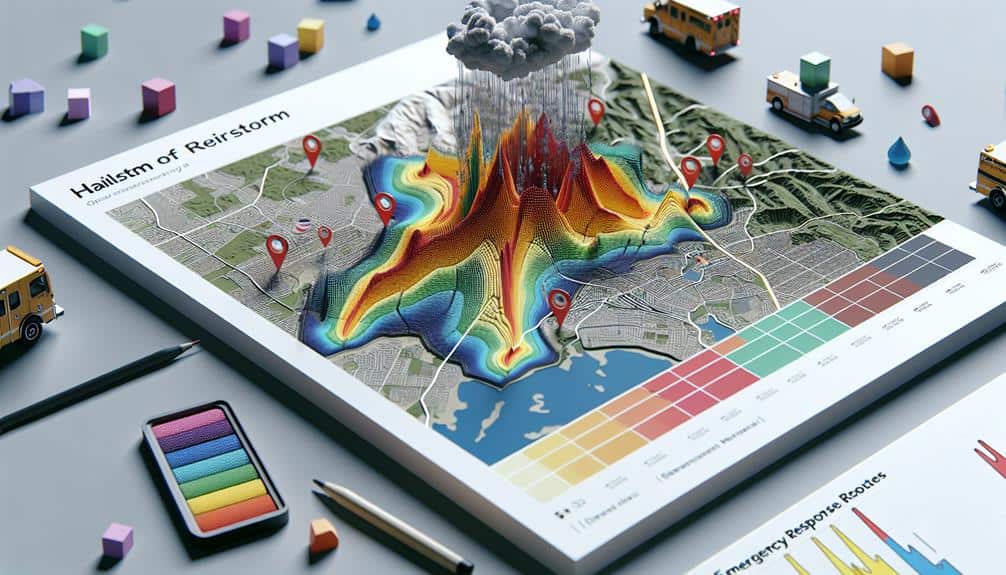We believe data visualization techniques are essential in hailstorm research because they transform complex datasets into actionable insights. They help us quickly analyze frequency, intensity, and trends through heat maps and time-series graphs, uncovering hidden insights that raw data alone can't provide. They enable real-time pattern recognition, which is critical for quick decision-making and improving early warning systems. Visual tools also enhance our predictive models by making output analysis more intuitive. By turning complex data into accessible visual stories, we improve communication and decision-making, helping us understand hailstorm dynamics more effectively. Let's explore how these techniques revolutionize our approach.
Key Points
- Data visualization uncovers hidden insights in complex hailstorm datasets, making analysis quicker and more accurate.
- Visual tools identify historical and predictive patterns in hailstorm frequency, distribution, and intensity.
- Real-time data visualization enhances immediate pattern recognition and reduces time lag in actionable decision-making.
- Visualizations improve predictive model interpretation and help in optimizing feature selection and algorithm efficiency.
Enhancing Data Interpretation
By leveraging advanced data visualization techniques, we can greatly enhance the interpretation of complex hailstorm datasets. We're talking about converting raw data into visually intuitive formats that allow for quicker and more accurate analysis. When we utilize data visualization, we can uncover research insights that might otherwise remain hidden in numerical tables and raw data files.
For instance, heat maps can illustrate the frequency and intensity of hailstorms across different geographic areas, while time-series graphs can reveal trends over extended periods.
In our quest for freedom from tedious data analysis, these visual tools empower us to make sense of large datasets swiftly. A well-designed infographic can summarize months of data collection in a single glance, allowing us to detect anomalies and patterns that inform further research. Through data visualization, we can also improve communication of our findings to stakeholders who may not be familiar with technical terminology. By converting intricate datasets into understandable visuals, we democratize the information, enabling more informed decision-making.
Ultimately, data visualization doesn't just simplify the interpretation process; it enriches our research insights, making it easier to draw actionable conclusions. This approach fundamentally transforms how we comprehend and react to hailstorm phenomena.
Identifying Hailstorm Patterns
We start by analyzing historical data trends to understand the frequency and distribution of past hailstorms.
By visualizing storm intensity patterns, we can identify key areas prone to severe hail events.
These techniques enable us to predict future occurrences and improve early warning systems.
Analyzing Historical Data Trends
To identify hailstorm patterns, we must meticulously analyze historical data trends, leveraging statistical tools and graphical representations to uncover meaningful insights. By employing data visualization techniques, we can transform raw datasets into intuitive visual formats, such as line graphs, heat maps, and temporal charts. These tools allow us to spot anomalies, seasonal trends, and long-term changes with greater clarity and precision.
In our research trends, we often start by aggregating data from various sources, including meteorological records, satellite imagery, and local weather stations. Once consolidated, we apply statistical analyses to highlight correlations and deviations. For instance, using scatter plots, we can correlate the frequency and intensity of hailstorms with other climatic variables like temperature and humidity.
Identifying these patterns is essential for several reasons. First, it helps us understand the underlying climatic mechanisms driving hailstorm occurrences. Second, it aids in predicting future events, providing valuable information for risk management and mitigation strategies. Lastly, these insights foster a deeper comprehension of regional and global climatic shifts, empowering us to make informed decisions.
Visualizing Storm Intensity Patterns
Visualizing storm intensity patterns involves converting complex meteorological data into clear, actionable visual formats that reveal the spatial and temporal distribution of hailstorm events. By employing advanced data visualization techniques, we can identify and analyze the intensity and trajectory of hailstorms with unparalleled accuracy. This capability is vital for both immediate storm tracking and long-term predictive modeling.
When we visualize storm intensity, we're not just looking at static images. We're creating dynamic models that evolve as new data comes in. These models help us understand how hailstorms develop, move, and dissipate over time. For instance, using heat maps and contour plots, we can highlight regions with the highest hail activity and track changes in intensity. This real-time visualization aids meteorologists in issuing timely warnings, potentially saving lives and reducing property damage.
Moreover, integrating predictive modeling with these visualization tools allows us to forecast future storm patterns based on historical data trends. This integration is essential for enhancing our preparedness and response strategies. By harnessing the power of data visualization, we're not only making sense of the present but also anticipating the future, providing a comprehensive approach to managing hailstorm risks.
Real-Time Data Analysis

In our approach to real-time data analysis, we prioritize immediate pattern recognition to enhance our understanding of hailstorm dynamics as they unfold.
With this capability, we can make quick decisions, reducing the time lag between data collection and actionable insights.
This, in turn, leads to enhanced data interpretation, allowing us to correlate meteorological variables more effectively and improve predictive models.
Immediate Pattern Recognition
Real-time data analysis allows us to identify patterns in hailstorm activity almost instantly, utilizing advanced algorithms and high-frequency data streams. By visualizing storm tracks, we can monitor the movement of hailstorms and analyze storm severity in real-time. This helps us detect weather anomalies that may suggest the formation of severe hail. The ability to predict hail size with high precision relies on the immediate identification of these patterns within the data, enabling us to fine-tune our predictive models.
We utilize sophisticated data visualization techniques to map out storm tracks and overlay them with various meteorological parameters such as wind speed, temperature, and humidity. This multi-layered approach enhances our capability to analyze storm severity and anticipate potential impacts. Detecting weather anomalies becomes more manageable when we can visualize deviations from normal patterns, enabling us to respond promptly to any emerging threats.
Furthermore, the integration of real-time data streams from numerous sources, including satellite imagery and radar systems, enhances our capacity to predict hail size. This combination of data ensures that our predictions aren't only timely but also highly accurate. Immediate pattern recognition helps us to stay ahead of the storm, safeguarding communities and assets.
Quick Decision Making
Building on our ability to recognize patterns instantly, we leverage this data for swift decision-making in live scenarios. By utilizing advanced data visualization techniques, we can achieve quicker responses and enhanced accuracy in hailstorm research. Real-time data analysis provides the crucial edge required when every second is important.
Through these visual tools, we can:
- Monitor storm progression: Track changes in storm cells dynamically to predict hail formation.
- Assess risk areas: Quickly identify regions most likely to be affected by severe hail, allowing for timely alerts.
- Optimize resource allocation: Direct emergency services and resources to areas with the highest need based on live data.
- Validate predictive models: Compare real-time observations with forecast models to improve future predictions.
Our ability to interpret data visually, in real-time, guarantees that we make informed decisions under pressure. This approach not only enhances our response time but also the accuracy of our actions.
The combination of rapid data visualization and real-time analysis is essential for mitigating the impact of hailstorms and safeguarding communities. Through such thorough methodologies, we continuously push the boundaries of what's achievable in weather research.
Enhanced Data Interpretation
Our real-time data analysis empowers us to interpret vast datasets with enhanced precision, enabling quicker identification of critical hailstorm patterns. By leveraging advanced visualization techniques, we're able to convert raw data into intelligible, graphical representations that highlight key variables and trends. This not only improves data accuracy but also facilitates immediate comprehension of complex information, allowing us to act swiftly.
Using visualization benefits, we can identify anomalies and correlations that might be missed through traditional data analysis methods. For instance, heat maps can reveal areas with the highest hail frequency, while time-series graphs can illustrate the progression and intensity of hailstorms. These visual tools transform raw meteorological data into actionable insights, making sure our interpretations are both rapid and reliable.
Moreover, the dynamic nature of real-time data analysis means we can continuously update our visualizations as new data streams in. This perpetual refinement enhances our understanding of hailstorm behaviors and helps us predict future occurrences with higher precision.
Data accuracy is paramount, and visualization techniques make sure that our analyses are both meticulous and immediate. By embracing these methods, we maintain the agility and freedom to respond to hailstorm threats with unparalleled efficiency.
Improving Predictive Models
To enhance the precision of hailstorm predictions, we need to integrate advanced machine learning algorithms with high-resolution meteorological data. This integration allows us to refine our predictive models and improve their performance. By focusing on model accuracy and effective feature selection, we can better understand the intricate patterns that precede hailstorms.
Key strategies include:
- Feature Selection: Identifying the most relevant variables from our datasets, such as temperature gradients, humidity levels, and wind speed, ensures our models focus on essential factors.
- Algorithm Optimization: Fine-tuning machine learning algorithms to handle large datasets efficiently and accurately is vital for real-time predictions.
- Data Integration: Combining various data sources, like satellite imagery and ground-based radar, enhances the depth and breadth of our models.
- Cross-validation: Implementing rigorous cross-validation techniques to assess model performance and avoid overfitting guarantees our predictions are reliable.
Communicating Findings Effectively

Effectively communicating our discoveries necessitates the strategic utilization of clear, data-driven visualizations that can transform intricate datasets into accessible insights for both scientific and non-scientific audiences. We need to harness the power of data visualization to craft compelling narratives that emphasize the importance of our research.
Storytelling through visualizations provides context and significance, making it simpler for stakeholders to grasp the consequences of hailstorm patterns and trends.
Interactive dashboards play a crucial role in this communication process. By providing dynamic, user-friendly interfaces, we promote greater engagement and allow users to explore the data at their own pace. These dashboards can integrate various visualization techniques, such as heat maps, time series plots, and scatter plots, to present multi-faceted data in an intuitive manner.
Users can filter, zoom, and delve into specific data points, which improves their comprehension and retention of the information presented.
Furthermore, these tools empower our audience to draw their own insights, fostering a sense of autonomy and independence. By leveraging data visualization and storytelling, we guarantee our discoveries resonate deeply, propelling informed decisions and meaningful actions across diverse sectors.
Visualizing Geospatial Data
In visualizing geospatial data, we leverage advanced mapping techniques to pinpoint the spatial distribution and intensity of hailstorms across diverse geographic regions. By employing geospatial mapping tools, we can analyze complex datasets to uncover patterns and correlations that aren't immediately apparent. These tools allow us to overlay multiple data layers—such as topography, climate conditions, and population density—onto a single map, facilitating a complete understanding of hailstorm behavior.
Interactive dashboards play an essential role in this process. They enable real-time data visualization and manipulation, allowing users to customize views and drill down into specifics. Through these dashboards, we can:
- Visualize hailstorm frequency and severity across different regions.
- Identify high-risk areas that require more focused research or preventive measures.
- Correlate hailstorm events with geographic features like mountains or plains.
- Track temporal changes to observe how hailstorm patterns evolve over time.
These methods empower us to generate actionable insights, ultimately driving more effective hailstorm research. The freedom to explore data interactively ensures that our analysis is both thorough and dynamic, adapting to new information as it becomes available.
Impact on Safety Measures

Harnessing our geospatial data visualizations, we can greatly improve safety measures by pinpointing the most vulnerable areas and tailoring our preparedness strategies accordingly. By mapping hailstorm occurrences, we identify hotspots and frequency patterns, enabling us to allocate resources more effectively. This targeted approach guarantees that emergency response teams are deployed where they're needed most, reducing reaction times and potentially saving lives.
Our visualizations also facilitate real-time monitoring, which is essential for timely emergency response. By integrating live weather data with historical trends, we can predict the likelihood of a hailstorm and issue warnings well in advance. This proactive stance allows communities to take precautionary measures, such as securing property and seeking shelter, minimizing the storm's impact.
Furthermore, our data-driven insights help policymakers develop robust safety measures that are both specific and adaptable. By continuously analyzing the evolving data, we can refine our strategies to address new vulnerabilities as they arise. This dynamic approach not only enhances our immediate response capabilities but also strengthens long-term resilience against hailstorms.
In essence, our advanced data visualizations empower us to protect lives and property more effectively, offering the freedom to live without the constant fear of unpredictable hailstorm damage.
Frequently Asked Questions
How Do Data Visualization Tools Integrate With Existing Hailstorm Research Software?
Our data visualization tools blend seamlessly with existing hailstorm research software, creating an explosion of insights. Integration methods guarantee software compatibility, while the user interface offers limitless customization options, giving us the freedom to tailor our analyses.
What Are the Common Challenges Faced While Visualizing Hailstorm Data?
We face interpretation challenges and data accuracy issues when visualizing hailstorm data. Our visualization tools must guarantee precise data representation to avoid misinterpretations. Integrating accurate datasets remains critical for reliability and effective analysis in our research.
Which Data Visualization Software Is Most Popular in Meteorological Research?
The most popular software in meteorological research is Python's Matplotlib for graphical analysis and radar interpretation. We also use R for statistical comparison and model validation, leveraging its flexibility and extensive libraries.
Can Data Visualization Techniques Be Applied to Historical Hailstorm Data?
Absolutely, we can apply data visualization techniques to historical hailstorm data. By analyzing trends and identifying patterns, we gain insights into past events, predict future occurrences, and develop strategies to mitigate hailstorm impacts more effectively.
How Do Researchers Ensure the Accuracy of Visualized Hailstorm Data?
We verify the accuracy of visualized hailstorm data by implementing rigorous data validation and quality control processes. We conduct spatial analysis and time series evaluations, confirming integrity and reliability before visual representation.


